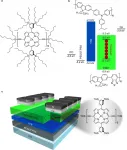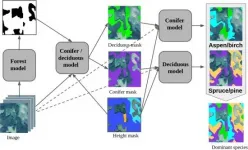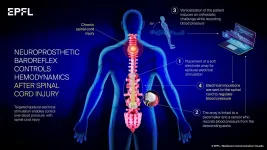(Press-News.org) CLEVELAND - Cleveland Clinic researchers have described for the first time how Zika virus (ZIKV) causes one of the most common birth defects associated with prenatal infection, called brain calcification, according to new study findings published in Nature Microbiology.
The findings may reveal novel strategies to prevent prenatal ZIKV brain calcification and offer important insights into how calcifications form in other congenital infections.
"Brain calcification has been linked to several developmental defects in infants, including motor disorders, cognitive disability, eye abnormalities, hearing deficits and seizures, so it's important to better understand the mechanisms of how they develop," said Jae Jung, PhD, director of Cleveland Clinic's Global Center for Pathogen Research & Human Health and lead author on the study. Dr. Jung, who is also chair of the Department of Cancer Biology, joined Cleveland Clinic from the University of Southern California in July.
Utilizing ZIKV-positive fetal brain specimens and preclinical disease models, the research team identified the protein BMP2 (bone morphogenetic protein 2) and the protease NS3 (nonstructural protein 3) as central players in ZIKV brain calcification.
Scans of ZIKV-positive brains collected and donated from Brazil during the 2015-2016 Zika outbreak revealed that cells called pericytes, which wrap around blood capillaries in the brain, collect around calcified lesions and have high concentrations of viral genetic material, suggesting a key role in infection-induced calcification.
"Several cell types have been explored for their involvement in ZIKV infection and pathology, but to our knowledge, this is the first study to investigate the role of pericytes," said Weiqiang Chen, PhD, a research associate in Dr. Jung's lab and the first author on the study.
The researchers infected fetal-derived pericytes with ZIKV and found that the BMP2 gene, which encodes the BMP2 protein, and several downstream osteogenic genes (related to bone formation) were expressed at higher levels and resulted in calcification. "We discovered that during ZIKV infection, some of the BMP family of genes and associated proteins function differently than during normal development," commented Dr. Chen.
Normally, BMPs activate specific proteins (the SMAD protein family) to modulate expression of osteogenic genes. Dr. Jung and his team showed in the study, however, that during ZIKV infection, a viral enzyme called NS3 transforms the BMP2 protein into a mature and biologically active form that enhances osteogenic gene expression. Effectively, NS3 activates BMP2 signaling pathways to trigger calcification and faulty brain development.
More research will be critical, but the study findings suggest that perhaps targeting NS3, either by preventing its expression or its binding with BMP2, may help to prevent ZIKV brain calcification in utero.
Dr. Chen is supported by a Pathway to Independence Award (K99/R00) from the National Institute of Dental and Craniofacial Research, part of the National Institutes of Health.
INFORMATION:
Advances in DNA sequencing have uncovered a rare syndrome which is caused by variations in the gene SATB1.
The study, co-authored by academics from Oxford Brookes University (UK), University of Lausanne (Switzerland), Radboud University (The Netherlands), University of Oxford (UK), University of Manchester (UK) and led by Max Planck Institute for Psycholinguistics (The Netherlands), discovered three classes of mutations within the gene SATB1, resulting in three variations of a neurodevelopmental disorder with varying symptoms ranging from epilepsy to muscle tone abnormalities.
Recognition of disorder will increase understanding and diagnosis
An international team of geneticists and clinicians from 12 countries identified 42 patients with mutations in the gene ...
People with sleep disorders commonly have a misperception about their actual sleep behaviour. A research group led by Karin Trimmel and Stefan Seidel from MedUni Vienna's Department of Neurology (Outpatient Clinic for Sleep Disorders and Sleep-Related Disorders) analysed polysomnography results to identify the types of sleep disorder that are associated with a discrepancy between self-reported and objective sleep parameters and whether there are any factors that influence this. The main finding: irrespective of age, gender or screening setting, insomnia patients are most likely to underestimate how long they sleep. The study has been published in the highly regarded Journal of Clinical Sleep Medicine.
Patients' misperceptions about the actual time that they sleep is a well-known ...
The ability to manipulate near-infrared (NIR) radiation has the potential to enable a plethora of technologies not only for the biomedical sector (where the semitransparency of human tissue is a clear advantage) but also for security (e.g. biometrics) and ICT (information and communication technology), with the most obvious application being to (nearly or in)visible light communications (VLCs) and related ramifications, including the imminent Internet of Things (IoT) revolution. Compared with inorganic semiconductors, organic NIR sources offer cheap fabrication over large areas, mechanical flexibility, conformability, ...
Mass spectrometers are widely used to analyze highly complex chemical and biological mixtures. Skoltech scientists have developed a new version of a mass spectrometer that uses rotation frequencies of ionized molecules in strong magnetic fields to measure masses with higher accuracy (FT ICR). The team has designed an ion trap that ensures the utmost resolving power in ultra-strong magnetic fields. The research was published in the journal Analytical Chemistry.
The ion trap is shaped like a cylinder made up of electrodes, with electric and magnetic fields generated inside. The exact masses of the test sample's ions can be determined from their rotation frequencies. The electrodes must create a harmonized field of a particular shape ...
Skoltech researchers and their colleagues from Russia and Germany have designed an on-chip printed 'electronic nose' that serves as a proof of concept for low-cost and sensitive devices to be used in portable electronics and healthcare. The paper was published in the journal ACS Applied Materials Interfaces.
The rapidly growing fields of the Internet of Things (IoT) and advanced medical diagnostics require small, cost-effective, low-powered yet reasonably sensitive, and selective gas-analytical systems like so-called 'electronic noses.' These ...
A genetic engineering method makes it possible to observe how woody cell walls are built in plants. The new research in wood formation, conducted by the University of Copenhagen and others, opens up the possibility of developing sturdier construction materials and perhaps more climate efficient trees.
The ability of certain tree species to grow taller than 100 meters is due to complex biological engineering. Besides needing the right amounts of water and light to do so, this incredible ability is also a result of cell walls built sturdily enough to keep a tree both upright and able to withstand the tremendous pressure created as water is sucked up from its roots and into its leaves.
This ability is made possible by what are known as the secondary cell ...
Skoltech scientists have developed an algorithm that can identify various tree species in satellite images. Their research was published in the IEEE Journal of Selected Topics in Applied Earth Observations and Remote Sensing.
Identifying tree species is essential for efficient forest management and monitoring. Satellite imagery is an easier and cheaper way to deal with this task than other approaches that require ground observations of vast and remote areas.
Researchers from the Skoltech Center for Computational and Data-Intensive Science and Engineering (CDISE) and Skoltech Space Center used a neural network to automate dominant tree species' identification in high and medium resolution images. A hierarchical classification model and additional data, such as vegetation height, helped ...
People with combined vision and hearing loss are nearly four times more likely to experience depression and more than three times more likely to suffer chronic anxiety, according to a new study published in the journal Frontiers in Psychology and led by Anglia Ruskin University (ARU).
Researchers analysed a health survey of 23,089 adults in Spain and found that while people suffering either vision or hearing loss both were more likely to report depression as those that were not, that risk increased to 3.85 times higher when respondents reported problems with both senses combined.
The study also found people with combined vision and hearing loss were 3.38 times more likely than the general population to report chronic anxiety.
It is understood to be the first study looking at ...
An international team of scientists headed by Grégoire Courtine at EPFL and CHUV and Aaron Phillips at the University of Calgary has developed a treatment that can dramatically improve the lives of patients with a spinal cord injury.
VIDEO: https://www.youtube.com/watch?v=UGXnuHgDWFU
"A serious and underrecognized result of these injuries is unstable blood pressure, which can have devastating consequences that reduce quality of life and are life threatening. Unfortunately, there are no effective therapies for unstable blood pressure after spinal cord injury". said Dr. Aaron Phillips, co-lead author of the study (see affiliations below). ...
Thursday, 28 January 2021: A study has found that adolescents who frequently use cannabis may experience a decline in Intelligence Quotient (IQ) over time. The findings of the research provide further insight into the harmful neurological and cognitive effects of frequent cannabis use on young people.
The paper, led by researchers at RCSI University of Medicine and Health Sciences, is published in Psychological Medicine.
The results revealed that there were declines of approximately 2 IQ points over time in those who use cannabis frequently compared to those who didn't use cannabis. Further analysis suggested that this decline in IQ points was primarily related to reduction in verbal IQ.
The research involved systematic review and statistical analysis on seven longitudinal studies ...







